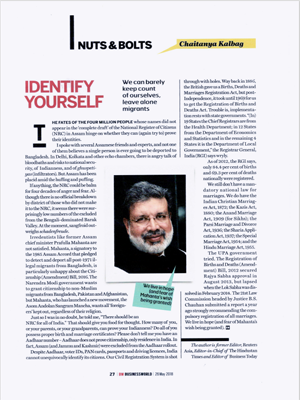Identify Yourself
[Business World]
Published date: 26 May 2018
The Fates Of the four million people whose names did not appear in the ‘complete draft’ of the National Register of Citizens (NRC) in Assam hinge on whether they can (again try to) prove their identities.
I spoke with several Assamese friends and experts, and not one of them believes a single person is ever going to be deported to Bangladesh. In Delhi, Kolkata and other echo chambers, there is angry talk of bloodbaths and risks to national security, of Indianness, and of ghuspetiyas (infiltrators).But Assam has been placid amid the huffing and puffing.
If anything, the NRC could be balm for four decades of anger and fear. Although there is no official breakdown by district of those who did not make it to the NRC, it seems there were surprisingly low numbers of the excluded from the Bengali-dominated Barak Valley. At the moment, sangfroid out weighs schadenfreude.
Irredentists like former Assam chief minister Prafulla Mahanta are not satisfied. Mahanta, a signatory to the1985 Assam Accord that pledged to detect and deport all post-1971 il legal migrants from Bangladesh, is particularly unhappy about the Citizenship (Amendment) Bill, 2016.The Narendra Modi government wants to grant citizenship to non-Muslim migrants from Bangladesh, Pakistan and Afghanistan, but Mahanta, who has launched a new movement, the Asom Andolan Sangram Mancha, wants all’ foreigners’ kept out, regardless of their religion.
Just so I was in no doubt, he told me, “There should bean NRC for all of lndia.” That should give you food for thought. How many of you, or your parents, or your grandparents, can prove your Indianness? Do all of you possess proper birth and marriage certificates? Please don’t tell me you have an Aadhaar number-Aadhaar does not prove citizenship, only residence in India. In fact, Assam (and Jammu and Kashmir) were excluded from the Aadhaar rollout.
Despite Aadhaar, voter IDs, PAN cards, passports and driving licences, India cannot unequivocally identify its citizens. Our Civil Registration System is shot through with holes. Way backin1886, the British gave us a Births, Deaths and Marriages Registration Act, but post Independence, it took until1969forus to get the Registration of Births and Deaths Act. Trouble is, implementation rests with state governments. “(In19States the Chief Registrars are from the Health Department; in 12 States from the Department of Economics and Statistics and in the remaining 4 States it is the Department of Local Government,” the Registrar General, India(RGI) says wryly.
As of 2012, the RGI says, only 84.4 per cent of births and 69.3 per cent of deaths nationally were registered.
We still don’t have a mandatory national law for marriages. We do have the Indian Christian Marriages Act,1872; the Kazis Act, 1880; the Anand Marriage Act, 1909 (for Sikhs); the Parsi Marriage and Divorce Act,1936; the Sharia Application Act,1937; the Special Marriage Act,1954; and the Hindu Marriage Act,1955.
The UPA government tried. The Registration of Births and Deaths(Amendment) Bill, 2012 secured Rajya Sabha approval in August 2013, but lapsed when the Lok Sabha was dissolved in February 2014. The2lstLaw Commission headed by Justice B.S. Chauhan submitted a report a year ago strongly recommending the compulsory registration of all marriages. We live in hope (and fear of Mahanta’s wish being granted).






